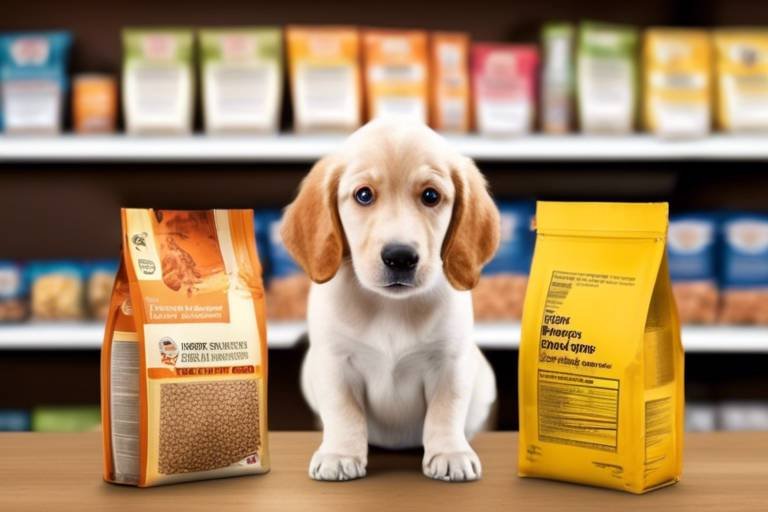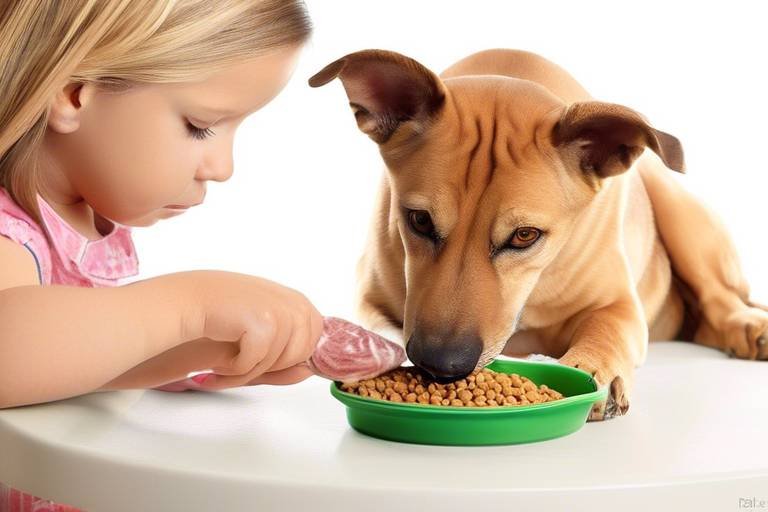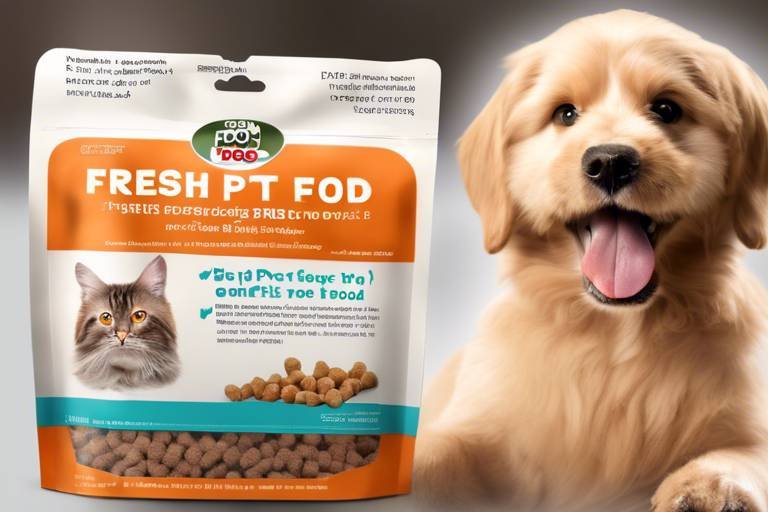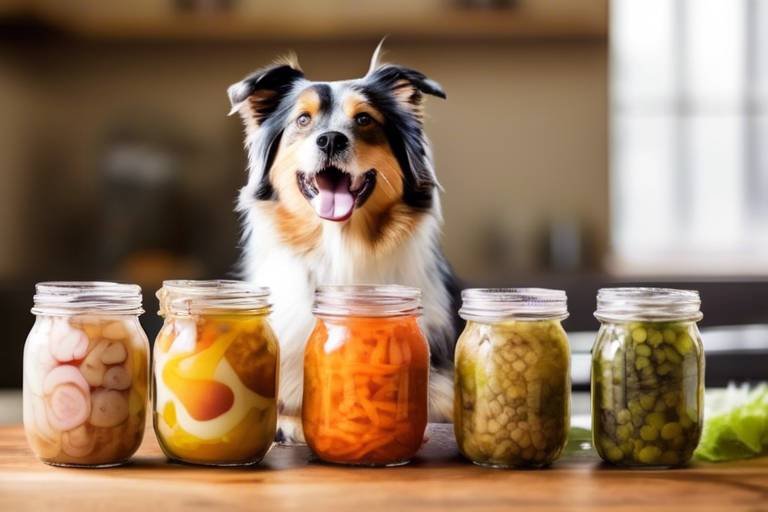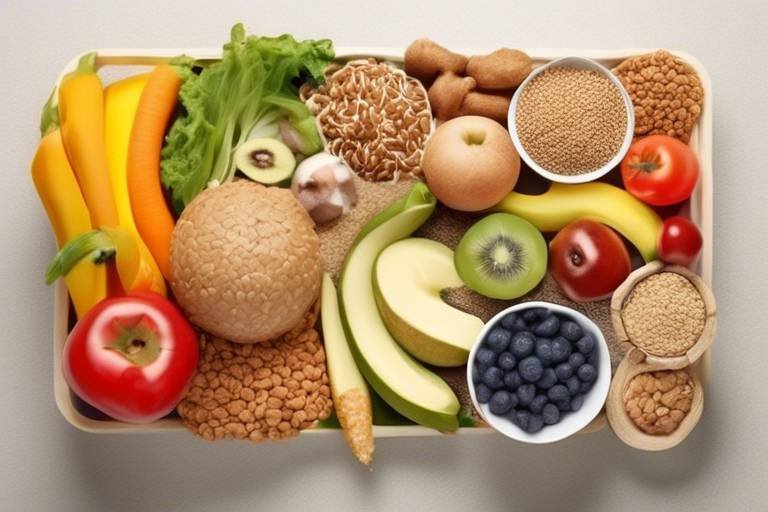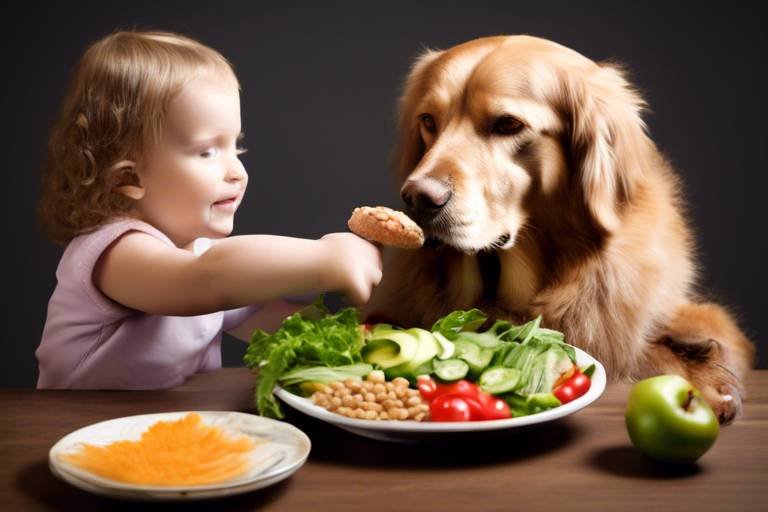How to Help Your Pet Avoid Food Boredom
As pet owners, we want our furry friends to be happy, healthy, and excited about their meals. However, just like us, pets can experience food boredom. Imagine eating the same meal every day; it can get pretty dull, right? Well, our pets feel the same way! In this article, we’ll explore various strategies to keep your pet's meals exciting and engaging, ensuring they enjoy their food and maintain a healthy appetite. After all, a happy pet is a healthy pet, and a little creativity can go a long way in transforming mealtime into a delightful experience.
Food boredom occurs when pets lose interest in their meals. It’s a common issue that can manifest in various ways, such as refusing to eat, eating slowly, or even scavenging for something more appealing. Recognizing the signs of food boredom is crucial for pet owners. If you notice your pet turning their nose up at their food or leaving their bowl untouched, it might be time to shake things up! Being proactive in addressing this issue can lead to a more enjoyable feeding routine for both you and your pet.
A diverse diet not only prevents boredom but also provides essential nutrients. Just like we need a balanced diet for optimal health, our pets do too! Exploring different food types can contribute to your pet's overall health and happiness. By introducing new flavors and textures, you can stimulate their senses and make mealtime an adventure. A varied diet can also help prevent food allergies and sensitivities, ensuring your pet remains vibrant and energetic.
One of the simplest ways to enhance your pet's meals is by adding fresh fruits and vegetables. These ingredients offer new flavors and textures, making mealtime more enjoyable and nutritious. Think of it as a culinary adventure for your pet! Just imagine their excitement when they discover a crunchy carrot or a juicy piece of apple mixed in with their regular food. Not only do these additions make meals more appealing, but they also provide a boost of vitamins and minerals.
Certain fruits, like apples and blueberries, are safe and healthy for pets. Here’s a quick list of some pet-friendly fruits:
- Apples (remove seeds)
- Blueberries
- Bananas
- Watermelon (seedless)
Understanding which fruits to include can add excitement to your pet's diet. Just remember to introduce new foods gradually and watch for any adverse reactions.
Vegetables such as carrots and peas can be great additions to your pet's meals. They provide crunch and flavor, keeping your pet engaged during mealtime. Here are some pet-approved veggies to consider:
- Carrots
- Peas
- Green beans
- Sweet potatoes
These veggies not only add variety but also contribute to your pet’s overall well-being.
Switching between different brands or formulas can also help combat food boredom. This practice introduces new tastes and aromas, keeping your pet curious and eager to eat. Just like we enjoy trying new restaurants, our pets appreciate a change in their dining experience. When rotating foods, it’s best to do it gradually to avoid any digestive upset.
Food puzzles and interactive toys can make mealtime fun! These tools encourage pets to work for their food, adding an element of play to their dining experience. Imagine your pet solving a little puzzle to get their kibble; it’s like a game that rewards them with a tasty treat! Not only does this keep them engaged, but it also promotes mental stimulation, which is vital for their overall health.
Selecting appropriate puzzle toys is crucial for your pet's engagement. The right toy can challenge them mentally while making mealtime more entertaining. Look for toys that are adjustable in difficulty, allowing you to increase the challenge as your pet becomes more skilled. This ongoing challenge keeps their interest piqued!
Creating homemade food puzzles can be a fun and cost-effective way to stimulate your pet. Simple household items can be transformed into engaging feeding challenges. For instance, you can hide their kibble inside a muffin tin and cover each hole with a tennis ball. Your pet will have to figure out how to get to their food, turning mealtime into an exciting quest!
Observing how your pet reacts to new foods and feeding methods is essential. Monitoring their preferences ensures that you tailor their diet to keep them happy and satisfied. Pay attention to their eating habits and adjust accordingly. If they seem to enjoy a particular fruit or toy, incorporate it more regularly into their routine. After all, your pet’s happiness is the ultimate goal!
Q: How can I tell if my pet is bored with their food?
A: Signs of food boredom include leaving food uneaten, eating slowly, or showing disinterest in mealtime.
Q: Can I mix different types of food together?
A: Yes! Mixing dry and wet food or adding fresh ingredients can enhance flavor and texture.
Q: Are there any fruits or vegetables I should avoid?
A: Yes, some fruits like grapes and certain vegetables like onions can be toxic to pets. Always research before introducing new foods.
Q: How often should I rotate my pet's food?
A: You can rotate food brands or flavors every few weeks, but always do it gradually to prevent digestive issues.

Understanding Food Boredom
Have you ever noticed your furry friend turning their nose up at their food? This phenomenon, known as food boredom, can be quite common among pets. Just like us, pets can grow tired of eating the same meals day in and day out. It’s a bit like having your favorite dish every single day; eventually, it loses its appeal. Recognizing the signs of food boredom is crucial for pet owners who want to keep their pets happy and healthy.
So, what exactly are the signs that your pet is experiencing food boredom? You might see them leaving their food untouched or even becoming disinterested during mealtime. They may also start to beg for treats more often, indicating that they’re looking for something different to satisfy their palate. This behavior can lead to unhealthy eating habits and even nutritional deficiencies if not addressed.
To combat food boredom, it's essential to understand the factors that contribute to it. Pets thrive on variety, and their meals should reflect that. Just like how we enjoy trying new cuisines or experimenting with flavors, our pets also appreciate a range of tastes and textures. A monotonous diet can lead to a lack of enthusiasm for food, which can affect their overall well-being.
Furthermore, food boredom can sometimes be a sign of underlying health issues. If your pet suddenly loses interest in their meals, it might be time to consult a veterinarian to rule out any medical concerns. Keeping an eye on their eating habits and being proactive can help ensure your pet remains in tip-top shape.
In summary, understanding food boredom is the first step in ensuring your pet enjoys their meals. By recognizing the signs and being attentive to their needs, you can take action to revitalize their feeding routine. Remember, a happy pet is a well-fed pet, and keeping mealtime exciting is key to maintaining their health and happiness.

Benefits of a Varied Diet
A varied diet is not just a fancy term thrown around by pet nutritionists; it’s a crucial aspect of keeping your furry friend both healthy and happy. Just like us, pets can get tired of eating the same thing day in and day out. Imagine having the same meal for breakfast, lunch, and dinner—yikes! That’s why introducing a mix of different foods can be a game-changer for your pet's eating experience. Not only does it keep their taste buds tingling with excitement, but it also provides essential nutrients that a single food source might lack.
When you diversify your pet's diet, you’re not just preventing boredom; you’re also contributing to their overall well-being. A varied diet can lead to:
- Enhanced Nutritional Value: Different foods offer different vitamins and minerals. For example, while kibble might provide a balanced diet, incorporating fresh fruits and vegetables can add fiber and antioxidants.
- Improved Digestive Health: A mix of ingredients can promote a healthier gut. Different fibers can aid digestion and prevent issues like constipation or diarrhea.
- Better Hydration: Some foods, especially wet ones, can help keep your pet hydrated, which is essential for their overall health.
- Increased Energy Levels: A balanced and varied diet can lead to more energy, making your pet more playful and active.
Moreover, introducing new flavors and textures can stimulate your pet's senses. Think of it as a culinary adventure for them! You might find that your pet is more excited about meal times, eagerly anticipating what delicious surprises await in their bowl. This excitement can also translate into a more engaged and playful pet, which is a win-win for both of you.
In conclusion, a varied diet is not just about preventing food boredom; it’s about enriching your pet's life. By mixing up their meals, you’re not only keeping things interesting but also ensuring they receive a well-rounded array of nutrients. So, next time you’re at the pet store, consider branching out a bit. Your pet will thank you with wagging tails and happy purrs!
Incorporating Fresh Ingredients
When it comes to keeping your pet's meals exciting, fresh ingredients can be a game changer! Adding a splash of color and flavor to your pet's diet not only makes mealtime more enjoyable but also boosts their nutritional intake. Imagine your furry friend diving into a bowl filled with vibrant fruits and crunchy vegetables—doesn't that sound delightful? By incorporating fresh ingredients, you can transform mundane meals into a culinary adventure that keeps your pet engaged and satisfied.
Fresh fruits and vegetables are packed with essential vitamins and minerals that contribute to your pet's overall health. For instance, fruits like apples and blueberries are not only safe for pets but also loaded with antioxidants. These little powerhouses can help strengthen your pet's immune system and keep them feeling energetic. Similarly, vegetables such as carrots and peas provide fiber, which is important for digestion. Plus, they add a satisfying crunch that many pets find irresistible!
But how do you go about incorporating these fresh ingredients into your pet's meals? It’s simpler than you might think! Start by introducing new ingredients gradually. You can mix small amounts of chopped fruits or vegetables into their regular food. This way, you can monitor how your pet reacts to these new flavors and textures. If they seem to enjoy it, feel free to get creative! You can even create a colorful fruit salad or a crunchy vegetable medley as a special treat.
| Fruit | Benefits |
|---|---|
| Apples | Rich in vitamins A and C; good for teeth. |
| Blueberries | High in antioxidants; supports brain health. |
| Bananas | Good source of potassium; great for energy. |
Always remember to wash fruits and vegetables thoroughly and remove any seeds or pits before serving them to your pet. Some fruits, like grapes and cherries, can be harmful to pets, so it’s crucial to do your research beforehand. By making informed choices, you can ensure that your pet enjoys their meals while staying safe and healthy.
In conclusion, incorporating fresh ingredients into your pet's diet is not just about preventing food boredom; it's about enhancing their overall well-being. With a little creativity and care, you can turn every meal into a delightful experience that your pet will look forward to. So, why not give it a try? Your furry friend will thank you with wagging tails and happy purrs!
Safe Fruits for Pets
When it comes to treating our furry friends, fruits can be a delightful addition to their diet, not only providing essential vitamins but also introducing new flavors that can keep their meals exciting. However, it’s crucial to know which fruits are safe for pets, as some can be harmful. For instance, apples are a fantastic choice; they are packed with vitamins A and C, and the crunchiness can make them a fun snack for your dog or cat. Just remember to remove the seeds and core, as they can pose a choking hazard.
Another excellent option is blueberries, which are rich in antioxidants and can be a great low-calorie treat. They are easy to share, and pets often love their burst of flavor. Additionally, bananas can be a sweet and satisfying treat in moderation. They are high in potassium and can be mashed into your pet's food for a tasty twist. However, due to their sugar content, they should only be offered occasionally.
Here’s a quick rundown of some :
- Apples: Remove seeds and core.
- Blueberries: A great antioxidant-rich snack.
- Bananas: Sweet and potassium-rich; serve in moderation.
- Watermelon: Remove seeds and rind; hydrating and refreshing.
- Pineapple: Packed with vitamins; serve fresh and in small amounts.
By incorporating these fruits into your pet's diet, you not only diversify their meals but also provide them with a healthy snack that they’ll look forward to. Remember to introduce any new food gradually and watch for any adverse reactions. It’s always best to consult with your veterinarian before making significant changes to your pet’s diet. This way, you can ensure that your furry friend enjoys their meals without any risks to their health!
Vegetables That Pets Love
When it comes to keeping your furry friend excited about mealtime, vegetables can be a game changer! Many pets enjoy the crunch and freshness that veggies provide, making them an excellent addition to their diet. Think of vegetables as the colorful sidekick to your pet's main course, adding not just flavor but also essential nutrients. For instance, carrots are not only delicious but also great for your pet's teeth, acting like a natural toothbrush as they chew. Similarly, peas are packed with vitamins and can be a fun treat for your pet to munch on.
But wait, there’s more! Not all vegetables are created equal when it comes to our pets. Some might be downright harmful, while others are packed with benefits. Here’s a quick rundown of some pet-approved veggies:
| Vegetable | Benefits | Serving Suggestions |
|---|---|---|
| Carrots | Rich in beta-carotene and good for dental health | Raw, steamed, or chopped into bite-sized pieces |
| Peas | High in protein and fiber | Fresh or frozen, mixed into meals |
| Sweet Potatoes | Great source of vitamins A and C | Baked or mashed, served as a side |
| Green Beans | Low in calories, high in fiber | Steamed or raw, as a crunchy snack |
Incorporating these vegetables into your pet’s diet can make a world of difference. Imagine your dog’s tail wagging with excitement as you serve them a bowl filled with colorful veggies mixed with their favorite kibble! It’s not just about nutrition; it’s about making mealtime an adventure. Plus, experimenting with different cooking methods—like steaming or roasting—can unlock new flavors that your pet will love.
Always remember to introduce new vegetables gradually to avoid any tummy troubles. Start with small amounts and observe how your pet reacts. If they gobble it up like it’s the best thing since sliced bread, you’ve found a winner! But if they turn their nose up at it, don’t be discouraged; every pet has their preferences, just like us humans.
So, the next time you’re in the kitchen, consider chopping up some of these pet-friendly vegetables. Not only will you be enhancing their meals, but you’ll also be giving them a little taste of the garden. After all, who wouldn’t want to enjoy a colorful, crunchy feast that’s good for them?
- Can all pets eat vegetables? Not all pets can eat the same vegetables. It's important to research which vegetables are safe for your specific pet.
- How do I introduce new vegetables to my pet? Start with small amounts and monitor their reaction. Gradually increase the quantity if they enjoy it.
- Are there any vegetables I should avoid giving my pet? Yes, some vegetables like onions and garlic can be toxic to pets. Always check before introducing new foods.
Rotating Food Brands
When it comes to keeping your pet's meals exciting, one effective strategy is . Imagine if you had the same meal every day; it would become dull and unappetizing, right? Pets can experience the same kind of food fatigue. By switching between different brands or formulas, you introduce new flavors, textures, and aromas that can reignite your pet's interest in food. This simple change can be the difference between a pet that eagerly anticipates mealtime and one that turns their nose up at the bowl.
But how do you go about rotating food brands? It’s essential to do it gradually to avoid any digestive upset. Start by mixing a small amount of the new food with your pet's current diet and slowly increase the proportion of the new brand over a week or so. This approach allows your pet's digestive system to adjust without causing any discomfort. Additionally, you can keep a food rotation schedule to help you remember which brands you’ve used and when to switch. Here’s a simple example:
| Week | Brand |
|---|---|
| 1 | Brand A |
| 2 | Brand B |
| 3 | Brand C |
| 4 | Brand A |
This table is just a starting point; feel free to customize it to suit your pet's preferences and nutritional needs. Remember, the key is to keep things fresh and engaging. You might even want to consider alternating between dry and wet food, as this can provide a variety of tastes and textures that keep your pet guessing and excited about their meals.
Moreover, don’t hesitate to explore different flavors within the same brand. For instance, if your pet loves chicken, try switching to a fish or lamb variant from the same brand. This simple twist can further enhance their dining experience. By keeping your pet's meals varied, you not only prevent boredom but also ensure they receive a well-rounded diet, which is crucial for their overall health.

Using Food Puzzles and Toys
When it comes to keeping your pet engaged during mealtime, food puzzles and interactive toys can be game-changers. Imagine your furry friend, tail wagging with excitement, working diligently to extract their meal from a cleverly designed toy. Not only does this approach make mealtime more enjoyable, but it also stimulates your pet mentally, turning a mundane feeding routine into a delightful challenge. The beauty of food puzzles lies in their ability to combine play with nutrition, ensuring your pet is not just eating but actively participating in their dining experience.
So, how do you choose the right food puzzle for your pet? First, consider their size and skill level. Some toys are designed for beginners, while others offer more complex challenges for seasoned puzzle solvers. A good puzzle toy should be durable and safe, made from non-toxic materials, and easy to clean. Look for options that allow you to adjust the difficulty level, so you can keep your pet challenged as they improve their skills. Remember, the goal is to keep them curious and engaged, not frustrated!
Creating DIY food puzzles can also be an exciting way to stimulate your pet without breaking the bank. You can use simple household items like cardboard boxes, muffin tins, or even old plastic bottles to craft engaging feeding challenges. For instance, you could fill a muffin tin with small treats and cover them with tennis balls, encouraging your pet to figure out how to remove the balls to get to the goodies. This not only provides a fun activity but also taps into your pet's natural instincts to forage and hunt for food.
Here’s a quick table to summarize some popular food puzzle toys and their features:
| Toy Name | Difficulty Level | Best For |
|---|---|---|
| Outward Hound Hide-A-Squirrel | Medium | Dogs |
| PetSafe Busy Buddy Twist 'n Treat | Adjustable | Cats & Dogs |
| Nina Ottosson by Outward Hound | High | Smart Pets |
Incorporating food puzzles into your pet's feeding routine can be a transformative experience. Not only does it help combat food boredom, but it also encourages your pet to use their brain, which is just as important as physical exercise. So, why not give it a try? Your pet will thank you with wagging tails and happy purrs!
Choosing the Right Puzzle Toy
This article explores various strategies to keep your pet's meals exciting and engaging, ensuring they enjoy their food and maintain a healthy appetite.
Food boredom occurs when pets lose interest in their meals. Recognizing its signs can help pet owners take proactive steps to reinvigorate their pet's feeding routine.
A diverse diet not only prevents boredom but also provides essential nutrients. Exploring different food types can contribute to your pet's overall health and happiness.
Adding fresh fruits and vegetables can enhance your pet's meals. These ingredients offer new flavors and textures, making mealtime more enjoyable and nutritious.
Certain fruits, like apples and blueberries, are safe and healthy for pets. Understanding which fruits to include can add excitement to your pet's diet.
Vegetables such as carrots and peas can be great additions to your pet's meals. They provide crunch and flavor, keeping your pet engaged during mealtime.
Switching between different brands or formulas can also help combat food boredom. This practice introduces new tastes and aromas, keeping your pet curious and eager to eat.
Food puzzles and interactive toys can make mealtime fun. These tools encourage pets to work for their food, adding an element of play to their dining experience.
When it comes to selecting the right puzzle toy for your pet, it's essential to consider their size, skill level, and preferences. Not all pets respond the same way to puzzle toys; some may find them frustrating while others are thrilled by the challenge. Start by observing your pet's behavior with different toys. Look for toys that are adjustable in difficulty, allowing you to increase the challenge as your pet becomes more adept at solving them.
Here are some key factors to consider:
- Durability: Ensure the toy is made from high-quality materials that can withstand your pet's chewing and playing.
- Size: The toy should be appropriately sized for your pet; too small, and they might choke, too large, and they may lose interest.
- Difficulty Level: Start with easier puzzles and gradually move to more complex ones to keep your pet engaged without causing frustration.
- Cleanability: Choose toys that can be easily washed to maintain hygiene.
By carefully selecting puzzle toys that match your pet's needs, you can create a mealtime experience that is not only nutritious but also mentally stimulating. Remember, the goal is to keep your furry friend excited about their food and eager to engage with their meals!
Observing how your pet reacts to new foods and feeding methods is essential. Monitoring their preferences ensures that you tailor their diet to keep them happy and satisfied.
Q: How do I know if my pet is bored with their food?
A: Signs of food boredom can include a lack of enthusiasm during mealtime, leaving food uneaten, or showing disinterest in their usual meals.
Q: Can I mix different types of food together?
A: Yes, mixing wet and dry food or incorporating fresh ingredients can make meals more exciting for your pet.
Q: How often should I change my pet's food?
A: It depends on your pet's preferences. Some pets enjoy variety, while others may prefer consistency. Monitor their reactions and adjust accordingly.
Q: Are puzzle toys suitable for all pets?
A: Most pets can benefit from puzzle toys, but it's important to choose the right size and difficulty level for your specific pet.
DIY Food Puzzles
Creating for your pet can be a delightful way to engage their mind while making mealtime an adventure! These puzzles not only keep your furry friend entertained but also provide mental stimulation, which is just as important as physical exercise. Imagine your pet’s excitement as they figure out how to get their favorite treats from a cleverly designed puzzle! The best part? You don’t need to spend a fortune on fancy toys; many DIY options are simple and use items you likely already have at home.
To get started, think about household items that can be transformed into fun feeding challenges. For instance, you can take an empty cardboard box and cut holes in it, just large enough for your pet to reach in and fish out their favorite kibble or treats. This simple design encourages them to use their paws and snouts, turning an ordinary meal into an exciting quest. You can also use old muffin tins by placing treats in each cup and covering them with tennis balls. Your pet will have to figure out how to remove the balls to access their goodies!
Here are a few more ideas to spark your creativity:
- Plastic Bottles: Remove the label and cut small holes in a clean plastic bottle. Fill it with kibble or treats, and let your pet roll it around to release the food.
- Egg Cartons: Use a cardboard egg carton, place treats in the cups, and close the lid. Your pet will have to open it to get to their reward.
- Towel Roll: Take a towel and roll it up with some treats hidden inside. Your pet will have to unroll the towel to find the goodies.
Remember, the goal is to challenge your pet without causing frustration. Start with simpler puzzles and gradually increase the difficulty as they become more adept at solving them. This way, you’ll keep their interest piqued and their food experience fresh and exciting!
Q: How often should I change the food puzzles for my pet?
A: It's a good idea to rotate the puzzles every few days to maintain your pet's interest. You can also change the treats or kibble inside to keep things exciting.
Q: Are there any foods I should avoid when creating DIY puzzles?
A: Yes, avoid foods that are toxic to pets, such as chocolate, grapes, and onions. Always stick to pet-safe treats and kibble.
Q: Can DIY food puzzles help with my pet's weight management?
A: Absolutely! By making your pet work for their food, you can slow down their eating pace, which can be beneficial for weight management. Just ensure the puzzle is challenging enough to keep them engaged!

Monitoring Your Pet's Response
When it comes to keeping your furry friend happy and their meals exciting, paying attention to their responses is crucial. Just like humans, pets have their own preferences and quirks, and understanding these can make a world of difference in their dining experience. Have you ever noticed how your pet reacts to a new flavor or texture? Their body language can tell you a lot! For instance, a wagging tail or an eager approach to their food bowl often indicates excitement, while a disinterested sniff or a turned-away head may suggest boredom or dislike.
One effective way to monitor your pet's response is to keep a feeding journal. This doesn’t have to be complicated; just jot down what you feed them, how they react, and any changes in their eating habits. Over time, you may notice patterns that can help you tailor their diet to their liking. For example, if your dog seems to devour chicken-flavored kibble but snubs the fish variety, it might be time to stick with what they love. Additionally, tracking their reactions can help you identify any potential food allergies or sensitivities, which is vital for their overall health.
Another aspect to consider is the timing of their meals. Some pets prefer to eat at specific times of the day, while others may enjoy a more flexible schedule. Observing your pet's behavior around mealtime can help you find that sweet spot. Do they seem more enthusiastic in the morning or after a long walk? Adjusting their feeding times can make a significant difference in their appetite and enjoyment of food.
It's also essential to keep an eye on your pet's physical condition. Changes in weight, energy levels, and even coat quality can be indicators of how well they are responding to their diet. If you notice your pet becoming lethargic or gaining weight unexpectedly, it may be time to reassess their food choices. On the flip side, a shiny coat and playful demeanor are usually signs that they are thriving on their current diet.
Lastly, don't forget about the importance of variety. While it’s great to have a go-to meal for your pet, introducing new flavors and ingredients can keep their interest piqued. However, when making changes, do so gradually. A sudden shift in diet can upset their stomach and lead to a negative experience. A good rule of thumb is to introduce new foods over a week, mixing them with their usual meals to help them adjust.
In summary, monitoring your pet's response to their food is not just about ensuring they eat; it's about enhancing their overall happiness and health. By keeping a close eye on their reactions, preferences, and physical condition, you can create a feeding routine that keeps them engaged and excited about mealtime.
- What are the signs of food boredom in pets? Look for signs like disinterest in food, leaving meals unfinished, or showing excitement for treats instead of their regular meals.
- How often should I change my pet's food? It’s best to rotate flavors or brands every few weeks, but always monitor how your pet responds to each change.
- Can I give my pet human food? Yes, but ensure it’s safe for them. Foods like carrots and apples can be great additions, while chocolate and onions should be avoided.
- How do I know if my pet has food allergies? Watch for symptoms like itching, digestive upset, or changes in behavior, and consult your vet for guidance.
Frequently Asked Questions
- What are the signs of food boredom in pets?
Food boredom can manifest in several ways. If your pet is suddenly disinterested in their meals, leaving food in the bowl, or showing a lack of enthusiasm during mealtime, these could be signs. Just like us, pets can get tired of eating the same thing day in and day out.
- How can I introduce new foods to my pet?
Introducing new foods should be done gradually. Start by mixing a small amount of the new food with their current diet. This way, you can monitor how they react and adjust accordingly. Think of it like trying a new dish at a restaurant; you wouldn't dive into the spiciest curry right away!
- Are there specific fruits and vegetables safe for pets?
Absolutely! Some safe fruits for pets include apples (without seeds), blueberries, and bananas. As for vegetables, carrots and peas are often favorites. Just remember to introduce them slowly and in moderation to avoid any tummy troubles!
- What are food puzzles and how do they help?
Food puzzles are interactive toys that require your pet to solve a challenge to get their food. They stimulate your pet mentally and add a fun twist to mealtime. It's like turning dinner into a game—who wouldn't love that?
- How often should I rotate my pet's food brands?
Rotating food brands can be done every few weeks, depending on your pet's preferences and dietary needs. This keeps their meals exciting and introduces them to different flavors and nutrients. Just like we enjoy variety in our meals, so do our furry friends!
- Can I make DIY food puzzles at home?
Definitely! You can create simple DIY food puzzles using household items like cardboard boxes or plastic bottles. Just ensure that the materials are safe and clean. It’s a fun project that can save you money while keeping your pet entertained!
- How do I know if my pet likes the new feeding method?
Monitoring your pet's behavior is key. If they eagerly engage with their food, show excitement during mealtime, and finish their meals, it’s a good sign they’re enjoying the change. Keep an eye out for any signs of discomfort as well, and adjust if needed.


